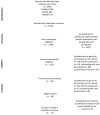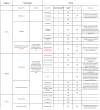Mental Health Problems among Young People-A Scoping Review of Help-Seeking
- PMID: 35162452
- PMCID: PMC8835517
- DOI: 10.3390/ijerph19031430
Mental Health Problems among Young People-A Scoping Review of Help-Seeking
Abstract
Young people's mental health is a public health priority, particularly as mental health problems in this group seem to be increasing. Even in countries with supposedly good access to healthcare, few young people seek support for mental health problems. The aim of this study was twofold, firstly to map the published literature on young people's experiences of seeking help for mental health problems and secondly to validate whether the Lost in Space model was adaptable as a theoretical model of the help-seeking process described in the included articles in this scoping review. A scoping review was conducted in which we searched for literature on mental health help-seeking with a user perspective published between 2010 and 2020 in different databases. From the 2905 studies identified, we selected 12 articles for inclusion. The review showed how young people experience unfamiliarity and insecurity with regard to issues related to mental health and help-seeking. A strong wish for self-reliance and to safe-guard one's own health were consistent among young people. Support structures were often regarded as inaccessible and unresponsive. There was a high level of conformity between the model on help-seeking and the analysed articles, reinforcing that help-seeking is a dynamic and psychosocial process.
Keywords: help-seeking; mental health; qualitative; scoping review; user perspective; young people.
Conflict of interest statement
The authors declare no conflict of interest.
Figures
Similar articles
-
Autonomy versus support: self-reliance and help-seeking for mental health problems in young people.Soc Psychiatry Psychiatr Epidemiol. 2023 Mar;58(3):489-499. doi: 10.1007/s00127-022-02361-4. Epub 2022 Sep 16. Soc Psychiatry Psychiatr Epidemiol. 2023. PMID: 36112162 Free PMC article.
-
Sub-Saharan African migrant youths' help-seeking barriers and facilitators for mental health and substance use problems: a qualitative study.BMC Psychiatry. 2016 Aug 2;16:275. doi: 10.1186/s12888-016-0984-5. BMC Psychiatry. 2016. PMID: 27484391 Free PMC article.
-
A user perspective on youth mental health services: Increasing help-seeking behaviour requires addressing service preferences and attitudinal barriers.Early Interv Psychiatry. 2025 Jan;19(1):e13584. doi: 10.1111/eip.13584. Epub 2024 Jun 9. Early Interv Psychiatry. 2025. PMID: 38853403
-
What are the barriers, facilitators and interventions targeting help-seeking behaviours for common mental health problems in adolescents? A systematic review.BMC Psychiatry. 2020 Jun 11;20(1):293. doi: 10.1186/s12888-020-02659-0. BMC Psychiatry. 2020. PMID: 32527236 Free PMC article.
-
Young People's Online Help-Seeking and Mental Health Difficulties: Systematic Narrative Review.J Med Internet Res. 2019 Nov 19;21(11):e13873. doi: 10.2196/13873. J Med Internet Res. 2019. PMID: 31742562 Free PMC article.
Cited by
-
Development of immersive learning framework (ILF) in achieving the goals of higher education: measuring the impact using a pre-post design.Sci Rep. 2023 Oct 17;13(1):17692. doi: 10.1038/s41598-023-45035-0. Sci Rep. 2023. PMID: 37848670 Free PMC article.
-
Adolescent help-seeking: an exploration of associations with perceived cause of emotional distress.Front Public Health. 2023 Oct 2;11:1183092. doi: 10.3389/fpubh.2023.1183092. eCollection 2023. Front Public Health. 2023. PMID: 37849721 Free PMC article.
-
Nursing Students' Attitudes Toward Seeking Psychological Help Associated to Self-Stigma and Perceived Social Stigma.J Caring Sci. 2023 Nov 15;12(4):221-227. doi: 10.34172/jcs.2023.33094. eCollection 2023 Dec. J Caring Sci. 2023. PMID: 38250005 Free PMC article.
-
Mental health in resource-limited settings: amplifying youth voices and approaches.Discov Ment Health. 2025 Mar 20;5(1):38. doi: 10.1007/s44192-025-00168-8. Discov Ment Health. 2025. PMID: 40111728 Free PMC article.
-
Next stop - mental health: a qualitative study of healthcare journeys from the perspective of young adults in Sweden.BMC Health Serv Res. 2025 Mar 12;25(1):364. doi: 10.1186/s12913-025-12510-5. BMC Health Serv Res. 2025. PMID: 40069805 Free PMC article.
References
-
- World Health Organization . Investing in Children: The European Child and Adolescent Health Strategy 2015–2020. World Health Organization; Copenhagen, Denmark: 2014.
-
- Malla A., Iyer S., McGorry P., Cannon M., Coughlan H., Singh S., Jones P., Joober R. From early intervention in psychosis to youth mental health reform: A review of the evolution and transformation of mental health services for young people. Soc. Psychiatry Psychiatr. Epidemiol. 2016;51:319–326. doi: 10.1007/s00127-015-1165-4. - DOI - PubMed
Publication types
MeSH terms
LinkOut - more resources
Full Text Sources
Medical




